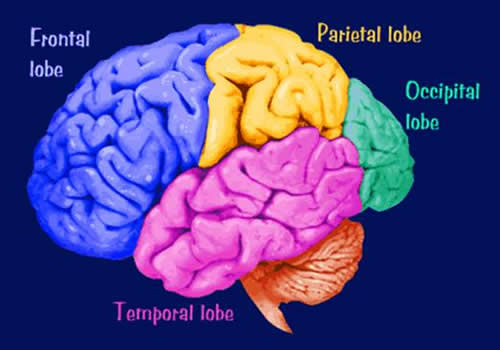 Brain Anatomy
Brain Anatomy
The brain and the spinal cord form the central nervous system. Weighing approximately 1-1.5 kg, the brain acts like a computer system regulating many of our bodily processes, including basic functioning, such as respiration, temperature, appetite, movement and cognitive processes like thoughts, memory and emotion.
Protected within the skull, the brain is a symmetrically shaped structure which is divided into 2 hemispheres: the right and a left hemisphere. The left side of the brain controls the right side of the body; the right side of the brain controls the left side of the body.
The cerebral cortex makes up the surface of the brain; it is highly folded giving it a very large surface area. The cerebral cortex is divided into 4 sections: the occipital, parietal, temporal and frontal lobe. Although each lobe is specialised to control particular functions, all work together to control the body.

Above: A diagram showing the four lobes of the cerebral cortex
The Frontal Lobe
The frontal lobe contains four main areas:
- The primary motor cortex - involved in the initiation of voluntary movements, particularly in the execution of distinct, well-defined movements
- The premotor area - which plays a key role in the planning of motor activity and the initiation of voluntary movement by controlling the orientation of the body and its limbs
- The prefrontal cortex - which is implicated in social behaviour and personality
- Broca’s area – is part of the prefrontal cortex and is important in the production of written and spoken language
Parietal Lobe
This has 3 main functions:
- Bringing together information about our sense of touch and joint position
- Making sense of the relationship between objects in space
- Aspects of language comprehension
Temporal Lobe
The temporal lobe contains four key regions:
- The primary auditory cortex receives information from the ears and plays an important role in the detection of patterns of sound and the location of sound
- Wernicke’s area is important in the comprehension of language
- The medial temporal lobe is involved in learning and memory
- The anterior temporal cortex is believed to store facts about people and the world
The Occipital Lobe
This is mainly concerned with vision. The primary visual cortex contains a map of the visual field that receives information from the eyes and relays it to the visual association cortex. The visual association cortex contains around 30 further maps involved in processing information about form, depth, movement and colour.